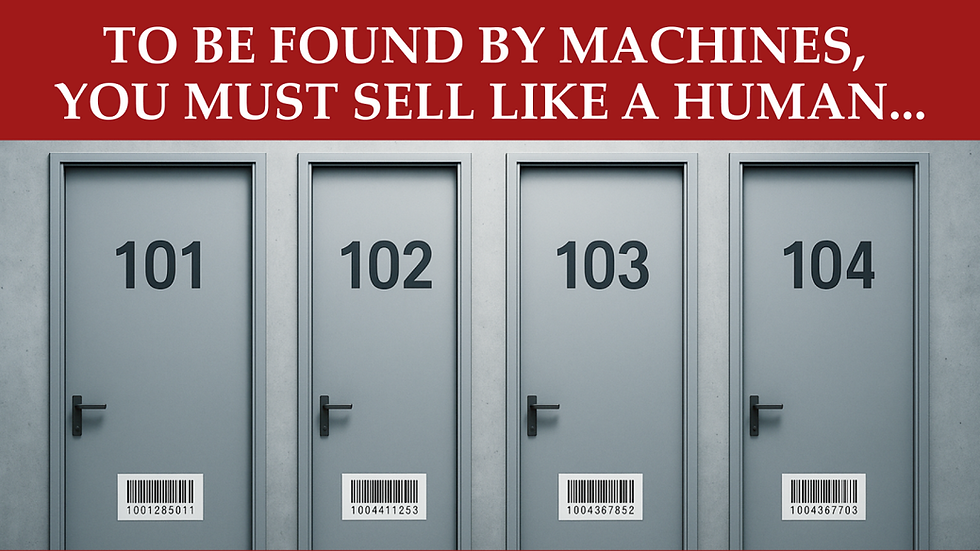3 new KPIs impacting sales strategy when using a sales engine with attribute-based selling
- Markus Mueller
- May 9, 2022
- 5 min read
Once you made the decision to exchange your online booking engine with a pro-active sales engine (including novel sales & conversion techniques like for example attribute-based selling), you also need to turn your attention to a new set of KPI’s to optimize performance.
We like to clarify attribute-based selling in this context. We are referring to the de-bundling of the room experience in various room features and attributes which are being upsold directly at the point of sales. This includes items like high floor, certain views, bathroom setups etc., all part of the room experience but not additional services like breakfast or other ancillaries beyond the room experience.
I Context is everything
When booking hotel experiences, the buying behavior of guests is largely influenced by the purpose of their trip, their accompanying travelers, length of stay and overall amount spent.
For example, the time spent booking a hotel and evaluating alternatives are significantly different when going for a routine trip travelling alone, going on a weekend trip with your spouse or looking for a summer holiday for the family.
In order to gain actionable insights for your selling strategy, the performance measurements should be distinguished through different booking flows relating to different buying behaviors and psychographics.
II Booking Flow Performance
Sold room products are measured through the following three main booking flows:
1. Lowest priced product
2. Recommended products to the booker
3. Self-selected preferences by the booker
Lowest priced product
The lowest priced product is a dynamic measure of the lowest available and offered room product to the booker for their desired stay period. In most cases, this is the standard or lead in room category of a hotel.
When taking the overall share of the lowest sold product booking flow in comparison to other booking flows, this measure is also quite useful to benchmark performance against third party distribution channels. It is one indicator of the sales engine upselling performance. We often see significant less products sold through the lowest selling product directly compared to third parties ranging from 30/70% ratios. This suggests 30% of all reservations buying the lowest priced product directly versus 70% lowest priced products sold through third party channels. While this does not tell you about the overall volume through those channels, it confirms a significant revenue upsell opportunity through direct channels.
Recommended products
Those are room products directly offered to the booker which are higher priced than the lowest selling product as well as other products suggested and include specific room features and attributes. For example, a bedroom on a high floor, balcony and midday sun using the social proof concept to convert a higher priced product.
Self-selected preferences
Room products are shown here according to the features and attributes selected by the booker. If the booker wanted a queen bed, away from elevator etc., matching products are being offered for the respective product value.
3 Month Booking Flow performance dashboard – Example Resort Property:

Match suggests that the booker selected their own preferences
Direct and most popular are recommended room products & attributes
Lowest price is the lowest priced product with no room attribute upselling
Key take-aways from this example:
Roughly 1/3 of bookers chose their preferences themselves and yielded an AVR of 114 EURO (15% higher than the lowest priced products), while staying 6.8 nights on average and spending additional 9 EURO per person for other services[1] at time of booking.
57% of bookers went for the suggested products for an AVR of 122 EURO (23% higher than the lowest priced products), while staying on average 5.4 nights and spending additional 7.4 EURO per person for other services at time of booking.
Only 13% booked the lowest available product price for an AVR of 99 EURO, while staying 6 nights on average and spending app 5 EURO per person for other services at time of booking.
The current trend also suggests that longer staying guests tend to either choose their own preferences or just trade down to no preferences for the lowest selling products while shorter staying guests tend to buy higher priced and suggested products.
In addition, guests who booked the lowest priced products also booked furthest in advance – deal hunting behavior.
Recommended selling adjustments for this hotel example
We adjusted the selling strategy and are pushing higher value products for shorter stays to find out at what price points are guests trading down to lower priced products – price elasticity testing.
Guests booked through Lowest Price are primarily targets for ongoing upselling activities prior to their arrival.
III Feature select to book (FSTB ratio)
In order to explain the following KPIs we need to make an important clarification of how we practice attribute-based selling.
We do not sell room attributes or features with single price points on top of a base room product. Instead, we sell room attributes and features as room feature combinations whereby the price point is always a total price point per room product not showing the actual price of each individual feature comprised in it. After all, some guests would like to pay for being close to the elevator, others being away from the elevator or others just do not care at all. The attributes and features appealing to a booker vary subject to their purpose of travel, with whom they are travelling and how long they will stay.
The overall number of selected features suggests in this context the true demand not influenced by a certain price point and value suggestion towards the booker.
The “Feature select to book” index (=FSTB) shows therefore the ratio of how many times people have selected this attribute or feature versus how many times it was sold.
If, for example, large balcony was selected 245 times in a week and only sold 200 times, the FSTB is 0,82. This suggests that either bookers have traded-off a large balcony to another feature or were not able to book it due to lack of rooms available having a large balcony (denial). In contrast, if the feature was selected only 190 times but sold 203 times, the STB is 1,07. This suggests that more bookers have bought a room with a large balcony but not actively selected it. This could either mean that other features were more important to them, or they simply did not care and just booked any product presented to them.
Subject to the hotel situation and overall availability of the respective attribute or feature the FSTB numbers must be put in this context and feature prices can be adjusted to optimize the right price point.
IV Feature denial ratio - FDR
The” Feature denial ratio” shows us how many times the feature was selected but not available and therefore not being displayed as a possible option to buy. So, for example, a large balcony was chosen 245 times for one week but only 223 products were actually shown with large balcony available. We consider this a denial ratio of 1,1, meaning there is an opportunity cost and the feature could have made more money if it would be more often available.
If the denial ratio is below 1 then this suggests that the inventory meets the demand. This ratio is extremely useful for potential new capital investments to understand the true feature demand and willingness to spend. After all, maybe it’s worth it to enhance some smaller balconies to large ones in the future.
Large Balcony | Week 1 | Week 2 | Week 3 | Week 4 |
Selected | 245 | 200 | 190 | 220 |
Displayed | 223 | 210 | 208 | 201 |
Booked | 200 | 180 | 203 | 201 |
FSTB (select to book) | 0,82 | 0,9 | 1,07 | 0,95 |
FDR (denial) | 1,1 | 1 | 0,9 | 1,1 |
Feature Price | €2,00 | €4,00 | €3,00 | €3,00 |

Now what, so what to do with those measures?
We are not suggesting that those KPIS are conclusive when using attribute-based selling. However new selling strategies require a sense and adapt approach. The KPIs described are best used to measure the trend and impact of regular adjustments of you selling strategy. In general, our findings confirm that it’s well worth for any type of property to start attribute-based selling, not even considering potential channel shifts and marketing benefits which arise.
To learn more about a sales engine with feature-based intelligence contact us for a free consultation on gauvendi.com.
Author:
Markus Mueller is the co-founder of GauVendi with over 25 years’ experience in leadership roles in multi-country and culturally diverse hospitality organizations across the Caribbean, Europe, Middle East and Asia within the tourism industry, holding an MBA with Distinction from Warwick Business School.




Outsource PHP Development Services for efficient and cost-effective web solutions. Our skilled team offers expertise in PHP programming, delivering customized websites and applications that meet your business requirements and enhance your online presence. As more people use PHP to make static and dynamic business websites, more developers with the right skills and knowledge of this framework are needed. You can hire and train a team of people to work on your websites and apps in-house, or you can look into Hire PHP Developers or team to work on your project full-time. With this method, you don't have to pay for a regular team and can still get the help of skilled developers to make a solution that fits your needs perfectly.
Writing assignments is an essential component of the academic program because it helps learners articulate themselves rationally. It supports analytical thinking, communication skills, learning retention, academic growth, and expertise implementation. Additionally, assignments promote introspection, assessment, and career and postsecondary education readiness. This all-encompassing strategy guarantees that students are prepared for their studies as well as their future careers. Although the goal of an assignment varies depending on the work, it usually evaluates a student's comprehension of a subject. In high school, college, and graduate school, assignments—which can take the form of essays, research papers, presentations, or creative projects—are used to push students to think critically, hone their writing and analytical abilities, and show that they understand the subject matter. When…
link link link link link link link link link link link link link link link link link link link link link link link link link link link link link link link link link link link link link link link link link link link link link link link link link link link link link link link link link link link link link link link link link link link link link link link link link link link link link link link link link link link link link link link link link link link link link link link link link link link link link link link link link link link link link link link link link link link